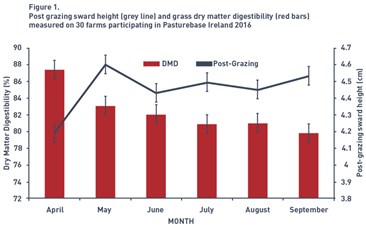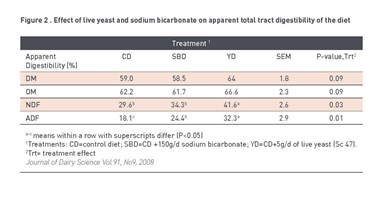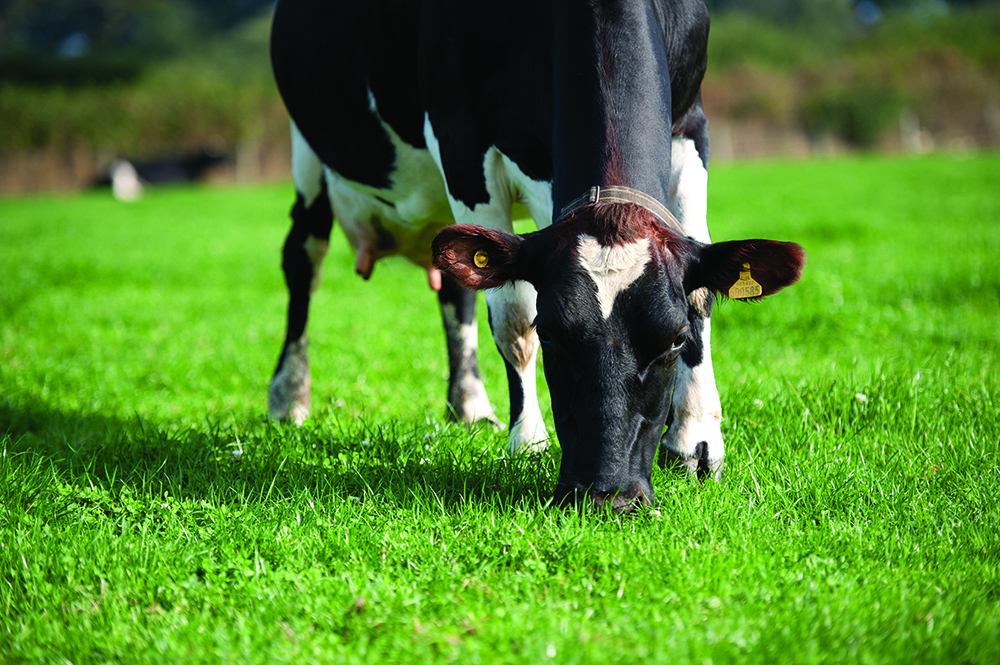As we look ahead to the mid-lactation period for dairy herds, it is important that herds strike the right balance between maximising grass intakes and balancing this with maintaining milk solids yield persistency and ensuring cows are back in calf after the 12-week breeding period
High rates of grass growth (of up to 80 kg DM/ha) during June and July are capable of supporting high stocking rates of up to 3.5 LU / HA on the milking platform. In turn, this can support high levels of milk solids yields under a 21-day grazing rotation, with 16-17 kg dry matter intake being comfortably able to support approximately 24 litres/cow/day at 4.1 % milk fat and 3.4% protein (equivalent to 1.9 kg of milk solids). This level of performance is possible where grass dry matters are greater than 17% dry matter and pre-grazing covers and grazing conditions are at optimum. Herds yielding above this will need to supplement with ideally a 14% crude protein compound with 3 kg fresh weight typically being required for cows yielding 30 litres.
During wet weather or grass shortages, increased compound feeding through the parlour and/or buffer feeding with a 78+ DMD grass silage (as baled surplus paddocks off the milking platform) will be required, as high grass intakes will not be possible, particularly with prolonged wet weather and this will show itself as poor rumen fill in the herd.
If herds are not fed relative to their energy requirements and milk yield, reduced conception rates and embryo mortality can be expected. Failure to increase compound feed rates through the parlour, or to buffer feed with high quality maize or grass silage during periods of wet weather or grass shortages, will impact on fertility, milk yield and impact on the lactation curve of the herd.
Prepare for the final 100 days of lactation now
Maintaining persistency of milk solids yield over the course of the summer months is critical in order to maximise income. Flattening the lactation curve and maximising persistency during summer ensures that cows are milking well when they enter the final 100 days of lactation in the autumn, when milk volumes typically decrease. During this time, relatively high levels of milk solids can be produced inexpensively due to high grass intakes and a smaller amount of concentrate being required once weather conditions allow.
As such, it is important to focus on maintaining milk yield persistency through the summer. A target for this is to limit the milk yield drop-off to less than 10% per month after peak milk yield in the herd, and typically July and August are where persistency can drop off in Irish herds. Minimising the drop off in persistency to less than 10% per month will have a major impact on production in the autumn and, in many cases, it has been possible to limit the drop to 5% or less with good nutritional management. For example, a herd yielding 28 litres on July 1st could be expected to yield approximately 22.5 litres by September 1st if the 10% drop per month was to be applied.
Strategies for maintaining milk persistency
In order to minimise this hit on performance, it is essential to keep a close eye on sward quality to ensure that your herd is only receiving high quality grazed grass. Providing concentrate feed to grazing cows relative to milk yield will increase milk yield and protein percentage and aid in maintaining persistency during the summer months.
It is vitally important that herds are entering the correct pre-grazing covers of 1400-1500kg DM/ha, that sward cleanout / graze out is as good as possible, and topping is employed where required. Grazing paddocks with pre-grazing covers in excess of 1600kg DM/Ha plus should be cut and baled and fed back in during periods of wet weather or drought.

Maintaining sward quality is vital as grass quality declines during June and July. Figure 1 demonstrates this drop in dry matter digestibility, which can directly impact milk yield and protein percentages. Every one unit drop in dry matter digestibility results in a decrease of approximately 0.24 litres per cow, per day!
The role of Actisaf Sc 47 in maintaining milk yield persistency
Feeding Actisaf Sc 47 live yeast has been scientifically proven to enhance the activity of the rumen microbes, in particular the fibre-digesting bugs and lactic acid-utilising microbes. Actisaf has consistently proven down through the years to reduce the risk of subacute rumen acidosis (SARA) in Irish grazing dairy herds and limit the drop off in milk fat percentage associated with SARA at grass. Importantly, however, Actisaf Sc 47 also aids the rumen in its ability to digest fibre by stimulating the rumen bugs leading to increased NDF and ADF digestibility over chemical buffers such as sodium bicarbonate (see figure 2).

This leads to increased digestion of grazed grass where digestibility is decreasing during the summer months, as the bugs release more energy from the stem of the grass, contributing to greater energy output from the rumen in the form of higher production of volatile fatty acids.
Actisaf Sc 47 is the only live yeast to consistently demonstrate this dual mode of action – reducing the risk of SARA and enhancing fibre digestion – resulting in increased feed conversion efficiency, enhanced milking persistency and higher milk constituents and good conception rates throughout the summer months. Depending on feed rate, Actisaf should be included at 1-2kg per tonne of feed, which will cost €10-20/tonne.
Actisaf - the live yeast you can trust…
Phileo Lesaffre Animal Care, the manufacturer and distributor of Actisaf Sc 47 have a deep knowledge and understanding of the mode of action of Actisaf Sc 47, based on years of research. All of the work on its mode of action has been peer reviewed in internationally-recognised research journals such as the Journal of Dairy Science.

